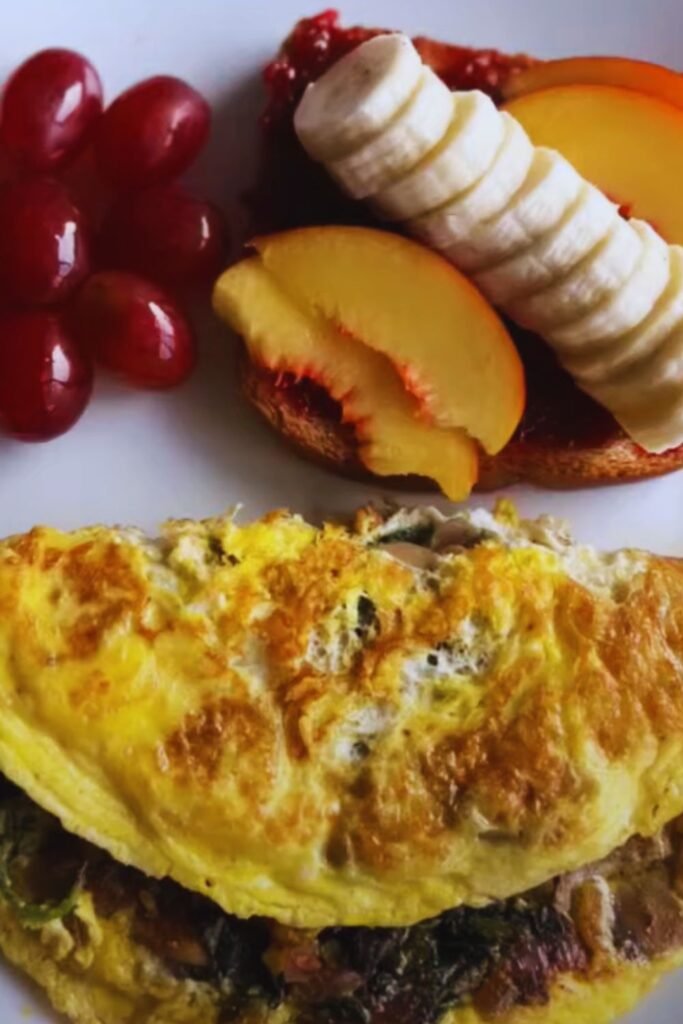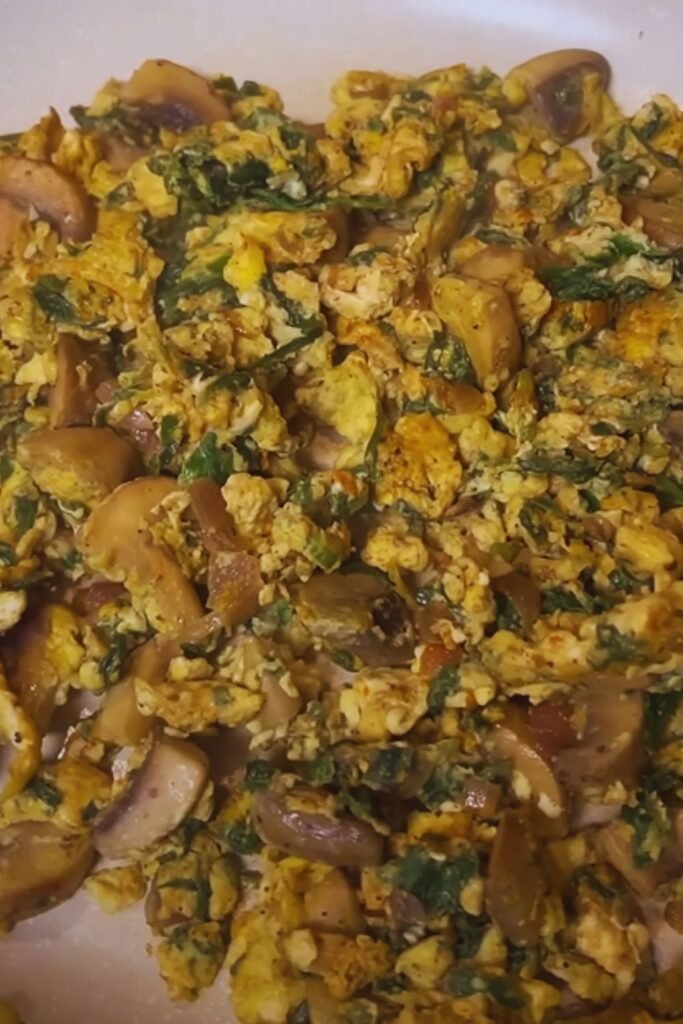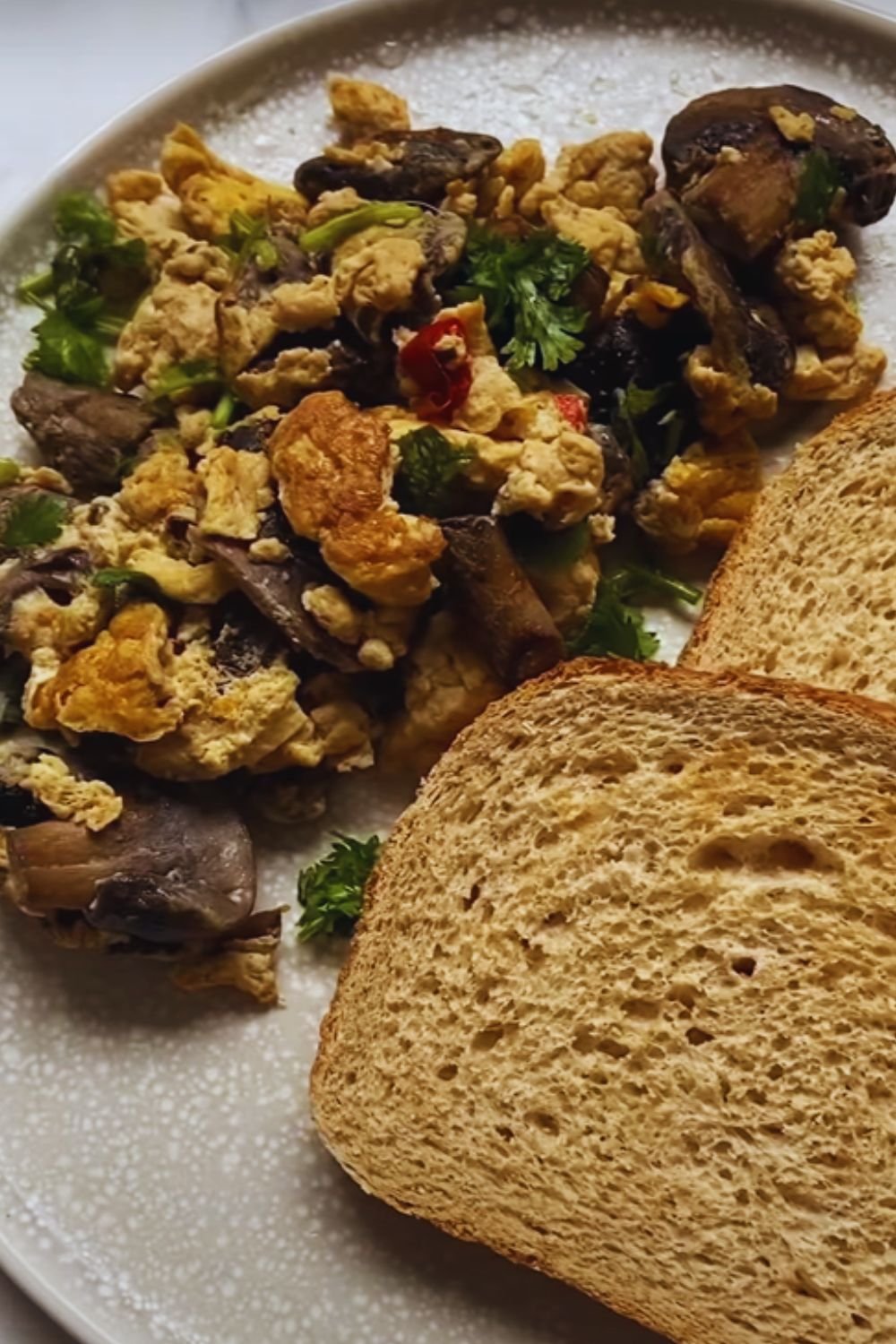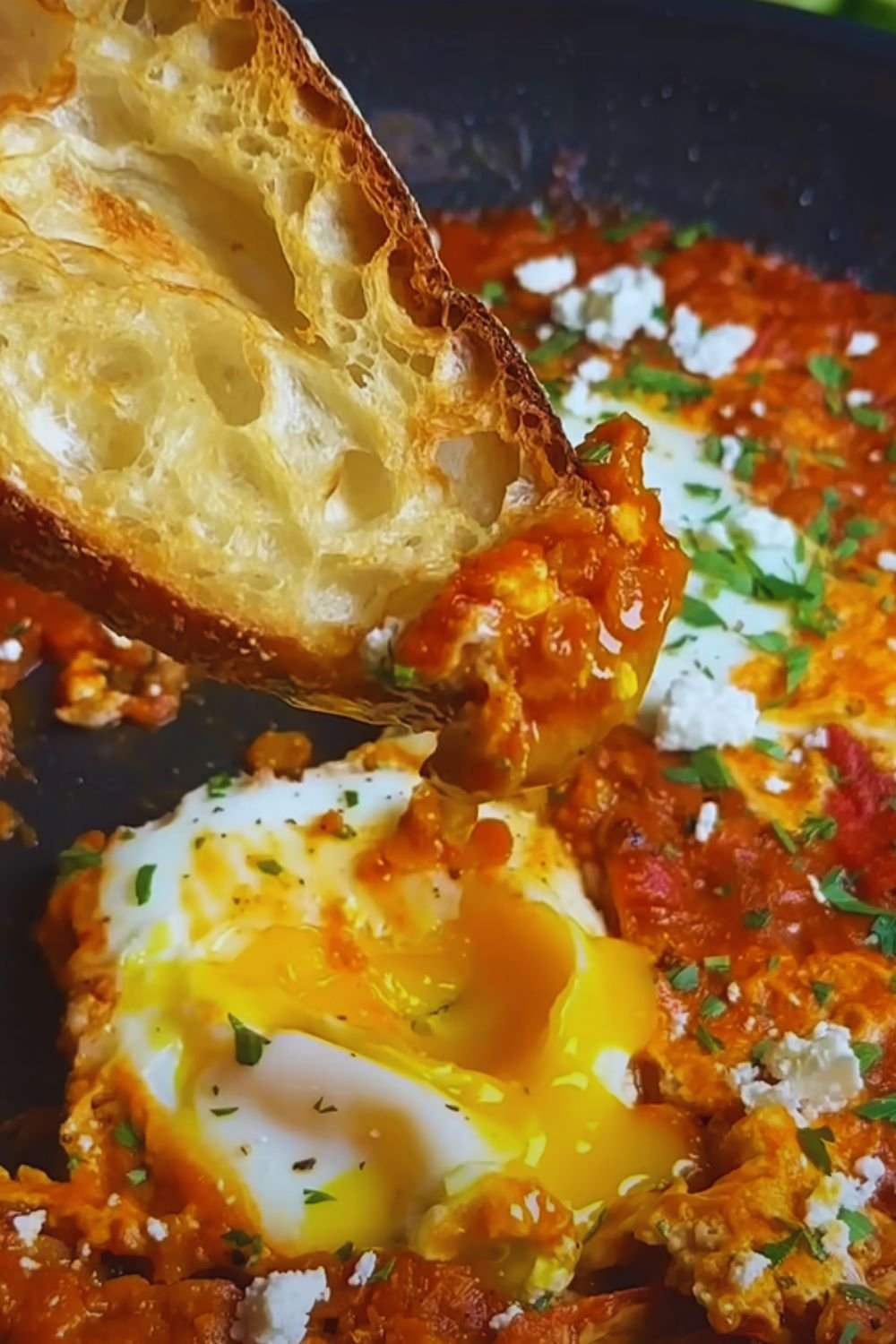There’s something magical about the combination of earthy mushrooms, vibrant spinach, and fluffy scrambled eggs that makes my taste buds dance with joy every single time. As someone who has experimented with countless breakfast recipes over the years, I can confidently say that this Mushroom-Spinach Scrambled Eggs recipe has earned a permanent spot in my morning routine.
Not only is this dish incredibly delicious, but it’s also packed with nutrients to fuel your day. The protein-rich eggs, iron-loaded spinach, and immune-boosting mushrooms create a powerhouse meal that’s as good for your body as it is for your palate.
In this article, I’ll walk you through every step of creating this breakfast masterpiece, from selecting the freshest ingredients to achieving that perfect scramble texture. I’ll also share some of my favorite variations and serving suggestions to keep this recipe exciting day after day.
Why This Recipe Stands Out
Before we dive into the cooking process, let me share why this particular combination works so beautifully together:
- Nutritional Synergy: The vitamin D in mushrooms helps your body absorb the calcium from eggs, while the iron in spinach becomes more bioavailable thanks to the vitamin C content.
- Texture Contrast: The silky eggs, meaty mushrooms, and slightly wilted spinach create an interesting mouthfeel in every bite.
- Flavor Balance: The earthiness of mushrooms, slight bitterness of spinach, and richness of eggs complement each other perfectly.
- Meal Flexibility: Works equally well for breakfast, lunch, or dinner.
- Quick Preparation: Ready in under 15 minutes from start to finish.
Essential Ingredients

For the best Mushroom-Spinach Scrambled Eggs, I always recommend using the freshest ingredients possible. Here’s what you’ll need:
| Ingredient | Quantity | Notes |
|---|---|---|
| Eggs | 4 large | Free-range or organic if possible |
| Fresh spinach | 2 cups | Baby spinach works best |
| Mushrooms | 8 oz (about 2 cups sliced) | Cremini, button, or shiitake |
| Unsalted butter | 2 tablespoons | Divided |
| Milk or cream | 2 tablespoons | Adds creaminess |
| Garlic | 2 cloves, minced | Adds depth of flavor |
| Fresh herbs | 1 tablespoon | Chives, dill, or parsley |
| Salt | To taste | I prefer sea salt |
| Black pepper | To taste | Freshly ground |
| Optional add-ins | As desired | See variations section |
Kitchen Equipment
Having the right tools makes this recipe even easier to prepare:
- Non-stick skillet (10-inch is ideal)
- Silicone spatula or wooden spoon
- Whisk
- Mixing bowl
- Sharp knife
- Cutting board
- Measuring spoons
Preparation Steps
Prepping Your Ingredients
Before I start cooking, I like to have everything ready to go:
- Crack eggs into a medium bowl, add milk or cream, and whisk until just combined. Don’t overbeat – a few visible streaks of egg white are actually good for texture.
- Clean and slice mushrooms (about ¼ inch thick).
- Wash spinach thoroughly and remove any tough stems.
- Mince garlic and chop herbs.
Cooking The Perfect Mushroom-Spinach Scrambled Eggs
Now for the main event! Here’s my step-by-step process for creating this delicious dish:
- Sauté the mushrooms: Heat 1 tablespoon butter in a non-stick skillet over medium heat. Add mushrooms and cook undisturbed for 2 minutes to allow them to brown. Stir and continue cooking for 3-4 minutes until golden and most of their moisture has evaporated.
- Add aromatics: Add minced garlic to the mushrooms and cook for 30 seconds until fragrant, being careful not to burn it.
- Wilt the spinach: Add spinach to the skillet and stir until just wilted, about 1-2 minutes. The volume will reduce dramatically – don’t be alarmed!
- Season the vegetables: Season the mushroom-spinach mixture with a pinch of salt and freshly ground black pepper. Transfer to a plate and keep warm.
- Prepare for scrambling: Wipe the skillet clean with a paper towel (no need to wash it) and return to medium-low heat. Add the remaining tablespoon of butter.
- Cook the eggs: Once butter is melted but not browned, pour in the egg mixture. Let it sit undisturbed for about 30 seconds until the edges begin to set.
- The scramble technique: Using a silicone spatula, gently pull the eggs from the edges toward the center, allowing the uncooked egg to flow to the edges. Continue this process, folding rather than stirring, until eggs are about 75% set but still look slightly wet.
- Combine components: Return the mushroom-spinach mixture to the skillet, folding it gently into the eggs. Remove from heat while eggs are still slightly underdone – they’ll continue cooking from residual heat.
- Final touches: Sprinkle with fresh herbs, adjust seasoning if needed, and serve immediately.
The Science Behind Perfect Scrambled Eggs
What separates good scrambled eggs from truly great ones? It’s all in the technique:
| Factor | Impact on Eggs | My Recommendation |
|---|---|---|
| Cooking temperature | Higher heat makes eggs tough and rubbery | Use medium-low heat for gentle cooking |
| Whisking intensity | Over-whisking incorporates too much air | Whisk until just combined with a few streaks |
| Cooking vessel | Affects heat distribution | Non-stick skillet prevents sticking without excess fat |
| Fat content | Affects richness and moisture | At least 1 tablespoon butter per 4 eggs |
| Liquid addition | Creates steam for fluffier texture | 1-2 teaspoons liquid per egg |
| Cooking time | Determines final texture | Remove from heat when slightly underdone |
| Stirring method | Affects curd size and texture | Fold gently rather than stirring vigorously |
Following these principles has helped me achieve consistently delicious results that my family and friends rave about.
Nutritional Powerhouse
One of the reasons I love this dish is its impressive nutritional profile. Here’s what you’re getting in each serving:
| Nutrient | Amount per Serving | % Daily Value* | Benefits |
|---|---|---|---|
| Protein | 18g | 36% | Muscle building, satiety |
| Vitamin K | 145mcg | 121% | Bone health, blood clotting |
| Vitamin D | 7mcg | 35% | Bone health, immune function |
| Iron | 4mg | 22% | Energy, oxygen transport |
| Folate | 105mcg | 26% | Cell division, fetal development |
| Calcium | 120mg | 12% | Bone and dental health |
| Potassium | 540mg | 11% | Heart and muscle function |
| Selenium | 24mcg | 44% | Antioxidant protection |
| Fiber | 2g | 7% | Digestive health |
| Calories | 285 | – | Balanced energy source |
*Based on a 2,000 calorie diet
Flavor Variations

While the classic version is delicious, I love experimenting with different flavor profiles:
Mediterranean Twist
- Add 1/4 cup crumbled feta cheese
- Include 2 tablespoons chopped sun-dried tomatoes
- Sprinkle with fresh oregano
- Finish with a drizzle of olive oil
Spicy Kick
- Add 1 finely diced jalapeño with the mushrooms
- Include 1/4 teaspoon smoked paprika
- Top with sliced avocado and hot sauce
- Garnish with cilantro instead of parsley
Umami Boost
- Use shiitake or maitake mushrooms
- Add 1 teaspoon soy sauce or tamari when cooking mushrooms
- Include 1 teaspoon toasted sesame oil
- Garnish with sliced scallions and sesame seeds
Herb Garden
- Increase fresh herbs to 3 tablespoons
- Use a mix of chives, dill, basil, and tarragon
- Add 1 tablespoon lemon zest
- Finish with a dollop of herb-infused soft cheese
Serving Suggestions
The beauty of this dish is its versatility when it comes to serving options:
Standalone Options
- On toasted sourdough bread with a side of roasted cherry tomatoes
- Alongside sliced avocado with everything bagel seasoning
- In a bowl with a spoonful of hummus and a drizzle of olive oil
- Wrapped in a warm whole grain tortilla for an on-the-go option
Complementary Side Dishes
- Fresh fruit salad with seasonal berries
- Roasted sweet potato hash
- Simple green salad with lemon vinaigrette
- Crispy bacon or turkey bacon (for non-vegetarians)
- Whole grain toast with avocado spread
Beverage Pairings
- Freshly squeezed orange juice
- Green smoothie
- Hot coffee or espresso
- Herbal tea like mint or ginger
- Sparkling water with lemon
Meal Prep and Storage
I’m a big fan of meal prepping, and components of this dish can be prepared ahead of time:
| Component | Prep Method | Storage Time | Reheating Notes |
|---|---|---|---|
| Sliced mushrooms | Store in paper bag in refrigerator | Up to 3 days | No need to reheat before cooking |
| Washed spinach | Pat dry, store with paper towel | Up to 5 days | May need to remove excess moisture |
| Minced garlic | Store in airtight container | Up to 1 week | Flavor intensifies over time |
| Chopped herbs | Store with slightly damp paper towel | 2-3 days | Add just before serving |
| Cooked mushroom-spinach mix | Refrigerate in airtight container | Up to 2 days | Reheat briefly before adding to eggs |
| Complete scramble | Not recommended | – | Best made fresh |
Common Mistakes to Avoid
Through years of making this recipe, I’ve learned what not to do:
- Cooking on high heat: This causes eggs to become tough and rubbery. Stick to medium-low.
- Overcooking the vegetables: Mushrooms should be golden but not shriveled, spinach should be just wilted.
- Seasoning too early: Adding salt to eggs too far in advance can break down proteins and make them watery.
- Stirring too vigorously: Gentle folding creates better texture than aggressive stirring.
- Using cold eggs: Room temperature eggs cook more evenly. Take them out 15 minutes before cooking.
- Overcrowding the pan: Use a pan large enough to allow proper cooking space.
- Not drying spinach properly: Excess water dilutes flavor and affects egg texture.
Making It a Family Favorite

As a parent, I’ve found this recipe to be wonderfully adaptable for family meals:
For Picky Eaters
- Chop mushrooms and spinach very finely so they blend into the eggs
- Add a small amount of their favorite cheese
- Serve with a familiar side like toast soldiers or fruit
Kid-Friendly Twist
- Create “egg muffins” by baking the mixture in a muffin tin
- Let kids customize with toppings in a “scramble bar” format
- Serve with fun dippers like sweet potato “fries”
Teaching Opportunity
This recipe is perfect for getting kids involved in cooking:
- Younger children can help whisk eggs and wash spinach
- Older kids can practice slicing mushrooms with supervision
- Teens can take responsibility for the entire cooking process
Frequently Asked Questions
Q: Can I use frozen spinach instead of fresh? Yes, but thaw it completely and squeeze out all excess moisture first. You’ll need about 1/2 cup of thawed frozen spinach to equal 2 cups fresh. Add it directly to the mushrooms without additional cooking time.
Q: What’s the best type of mushroom to use? Cremini (baby portobello) mushrooms offer the best flavor, but white button mushrooms work well too. For a gourmet version, try shiitake or a wild mushroom blend.
Q: How can I make this dairy-free? Replace butter with olive oil or a plant-based butter alternative. Instead of milk, use unsweetened almond milk or another plant-based milk. The texture will be slightly different but still delicious.
Q: Can I add cheese to this recipe? Absolutely! Add 1/4 cup of grated cheese like cheddar, goat cheese, or feta when the eggs are about 80% cooked. The residual heat will melt the cheese perfectly.
Q: Is there a way to make this recipe ahead for busy mornings? While the complete dish is best fresh, you can pre-cook the mushroom-spinach mixture and refrigerate it for up to 2 days. In the morning, quickly scramble your eggs and fold in the reheated vegetable mixture.
Q: Can I use egg whites only? Yes, substitute 8 egg whites for the 4 whole eggs. The texture will be lighter and the color less vibrant, but the dish will have fewer calories and fat.
Q: How can I make this recipe even more filling? Add 1/4 cup of cooked quinoa, diced roasted sweet potatoes, or black beans to increase fiber and make it more substantial.
Q: Why do my eggs sometimes release water when cooking? This happens when eggs are cooked too quickly on high heat or when salt is added too early. Cook on medium-low and add salt just before cooking or after the eggs are done.
Seasonal Adaptations
One thing I love about this recipe is how easily it adapts to seasonal produce:
Spring
- Add fresh asparagus tips, cut into 1-inch pieces
- Incorporate spring peas
- Use abundant spring herbs like chives and dill
Summer
- Add diced zucchini or yellow squash
- Include halved cherry tomatoes
- Garnish with fresh basil
Fall
- Use wild mushroom varieties
- Add diced roasted butternut squash
- Incorporate sage or thyme
Winter
- Add roasted red peppers for color and vitamin C
- Use heartier greens like kale instead of spinach
- Incorporate warming spices like nutmeg or cumin
Sustainability Notes
As someone who cares about the environment, I try to make sustainable choices in my cooking:
- Eggs: Look for pasture-raised eggs from local farms when possible
- Mushrooms: These have one of the lowest environmental footprints of any food
- Spinach: Buy organic when you can, as conventional spinach can have high pesticide residues
- Seasonal adaptations: Following the seasonal suggestions above reduces food miles
- Food waste: Use mushroom stems to make stock and spinach stems in smoothies
Final Thoughts
There you have it – my complete guide to making extraordinary Mushroom-Spinach Scrambled Eggs. What begins as a simple breakfast can easily transform into a nutritional powerhouse that adapts to your tastes, dietary needs, and what’s available in your kitchen.
I encourage you to use this recipe as a starting point and make it your own. The beauty of cooking lies in experimentation and adaptation. Perhaps you’ll discover a combination that becomes your signature breakfast dish!
Remember, great cooking doesn’t have to be complicated. Sometimes the simplest ingredients, treated with care and attention, create the most memorable meals. This dish proves that point perfectly.
Now, I’d love to hear from you! Have you tried making Mushroom-Spinach Scrambled Eggs? Do you have a special ingredient or technique that takes your scrambled eggs to the next level? Share your experiences and let’s continue the conversation about this versatile, nutritious dish.


